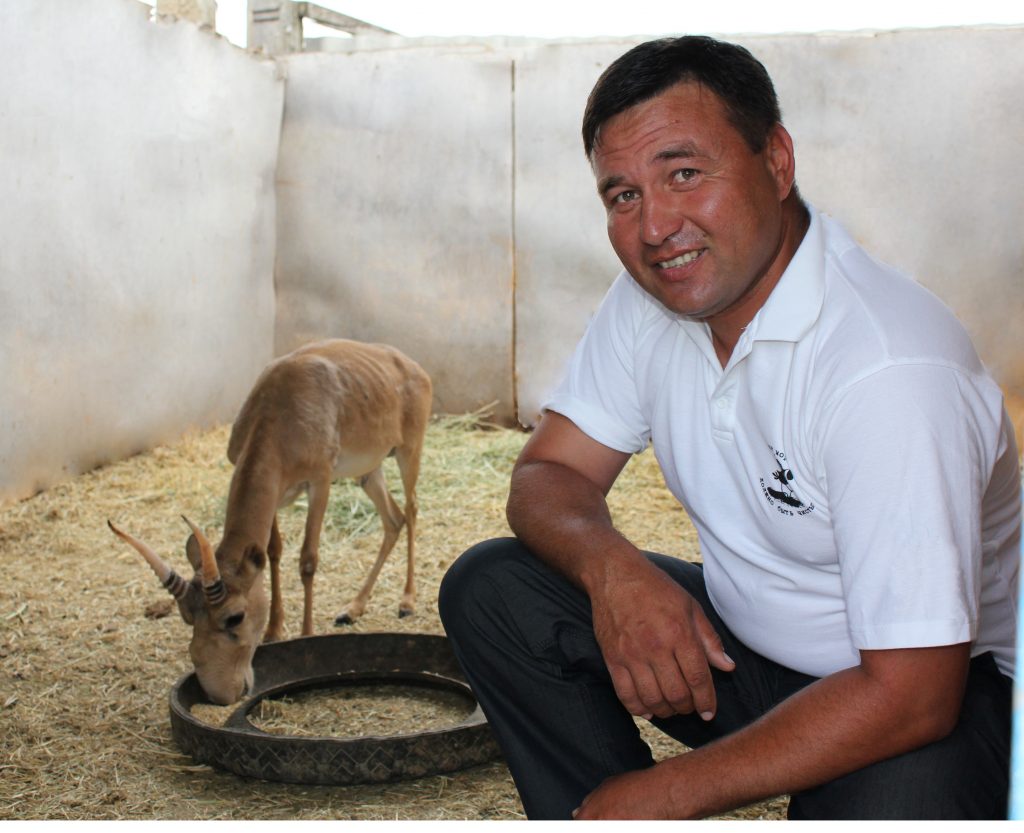Aslan Baideldinov is an animal husbandry technician who has been working at the Centre for Wild Animals of the Republic of Kalmykia since 2003.

Editor: Aslan, how did you start working on saiga conservation?
A.B.: I have been fond of animals since I was a kid. We kept ducks, geese, cows, and sheep at home. Our parents taught us to take care of the animals day-to-day. I knew all our animals by sight and all of them had names. I first saw saigas when I was at primary school. There were lots of them then and we often observed them passing by our school. When I first saw them I formed a lifelong memory of these animals, the way they run and the sense of a live steppe. This is why when I had the chance to work at the saiga breeding center I did not hesitate for a moment. I must say I am lucky because I not only do the job I like but also have the opportunity to meet scientists and experts from Russia and abroad, who frequently visit our Centre. When the visitors really appreciate our work I feel happy and proud because I, too, have contributed to the successful work of our little saiga “shelter”.
Editor: What does your typical day consist of?
A.B.: There is nothing heroic in my work. My work day usually involves several types of work. In the first half of the day and at the end I take care of the saigas, feed them and make a round of the enclosure. Then we make the hay, repair fences, clean enclosures and so forth. Visitors come in the second half of the day; therefore, we aim to get everything ready before their arrival. Usually, if don’t have another job to do, I like to conduct excursions to the enclosures and tell people about my pets.

Editor: Can you tell us an interesting story about saigas?
A.B.: Yes, of course. I remember when saigas were brought here at the very beginning, from our first temporary enclosure, which was in Har-Buluk village, I used to come to the enclosures to feed and observe the saigas and clean the enclosures. I would hum a simple tune and the saigas would usually stay close to me. After a long time, I visited the saigas, which had already grown up, humming my tune. Hearing my voice they rushed over to me from a distant corner of the enclosure and started walking around me and smelling the feeding rack. I at once filled it up. It was then that I understood that the saigas were accustomed to my voice and recognized it at once. So, nobody can say that these saigas are wild, after all.
Editor: What do you like most about saigas?
A.B.: Most of all I like their temperament. They are so free and majestic. It is impossible to describe the energy and force of life coming from them. They can only be felt.
Editor: What are the main problems in your work?
A.B.: Of course, no work is free of problems. The main one is that we would like to get more support (and not only financial) from the state. The situation is catastrophic. Saiga numbers are declining from day to day.
Editor: How can obstacles be removed from your work?
A.B.: I believe that irrespective of what we are involved in, any obstacles can be removed by hard work, responsibility and lack of indifference. People should put their hearts and souls into their work then the result will also make their hearts rejoice.
Editor: Which is the best part of your work?
A.B.: The first thing is that our work is very noble– protecting these ancient antelopes. We are happy that we can show them to our children. The best thing is to see saigas themselves rather than in pictures and books. Secondly, there is an opportunity to meet people from different countries and thirdly, my work is not banal or dull as this is the first saiga breeding center in Russia.
Editor: What hopes do you have for saigas, yourself and colleagues?
A.B.: I am very hopeful that the numbers of saigas will stop declining in the wild and the saiga will not turn into a legend for people.
p.s. The interview was published in Saiga News issue 13
